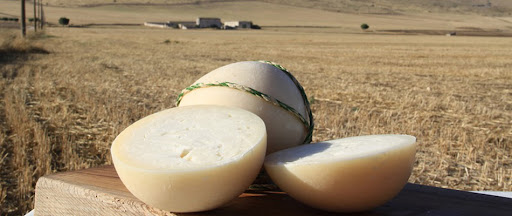Pallone di Gravina is a cheese which is attributed a spherical shape.
Born and protected in the town of Gravina in Puglia, known as the "Little Matera" for its scenic beauty, a site of excellence for the cultivation of wheat and wine, it is no coincidence that the heraldic coat of arms of the town bears this specificity.
The origins are very remote: the finds found in the Archaeological Park of Botromagno in Gravina in Puglia, give various testimonies. In fact, among the funeral decorations of the ancient Greek Sidion, then Roman Silvium, tools for the processing of milk and, even, a grater or grated cheese for hard-skinned cheeses such as Pallone di Gravina. In more recent times, its processing dates back to the era of transhumance when cattle and flocks of thousands of animals passed along the Apulian sheep tracks. Gravina was an important rest stop on the Brandanico-Tarantino sheep track that connected Melfi (Potenza) with the seaside town of Castellaneta. The same Pallone is already mentioned in the New Agricultural Encyclopedia of 1859.
The name, as you can easily guess, derives from the ball shape of the cheese which is similar in appearance to a caciocavallo, however, without the head. For convenience, the "balloons" were tied two by two and transported on the back of the donkey in transhumance or to hang them in the tuff caves where, in some cases even today, they mature. Weight? It can reach ten kilos.
The raw milk used for the production of this cheese with ancient origins comes from controlled farms that follow a diet based on 100% GMO free feed and forage. Pallone di Gravina is obtained by coagulating whole raw milk with kid or lamb rennet paste. After breaking into small grains, the curd is left to settle. The acidification phase, the most delicate, occurs consecutive to the breaking, collecting the mass and depositing it on a plane. The dough remains for about 24 hours, at the end of which it is sliced and heated with boiling water which allows it to be stretched.
Once the typical spherical shape is achieved with a slow handling process, the cheese goes into brine, where it remains for 24-36 hours depending on the weight and then goes to dry. Once this is finished, the Pallone can age in natural cellars, where it takes on more and more pronounced aromas, once they were hung in the tuff caves where they matured for months: after three months the spiciness is felt, the paste takes on colors that turn to the intense golden and perfumes give notes of caramel that are added to the herbaceous typical of the cheeses of this area.
In August 2010, after a brief process, it became a "Traditional Regional Product" through the review by the Ministry of Agriculture. In October 2012 it became a Slow Food Presidium





